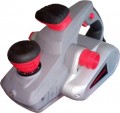Power consumption
The total power consumed by the electric planer during operation. The more powerful the tool, the generally higher its productivity and the better it is suitable for large volumes of work and/or hardwoods. Here, however, it must be taken into account that the effective power (the power supplied by the unit directly to the working tool) is anyway lower than the consumed one, but it is far from always indicated. Therefore, it is quite possible to compare different models with each other precisely in terms of power consumption.
Note that more power means higher electricity consumption, and also, most often, more weight and cost of the tool. Therefore, it does not always make sense to chase the most powerful units. So, for occasional use and small volumes of work, a power of 500-600 W is considered quite sufficient; for regular work on relatively soft wood, 700-800 W is enough, and professional models have a power of more than 1000 W.
Rotation speed
The maximum speed of rotation of the working tool of the electric planer — a drum with knives attached to it. In modern models, this figure is practically never lower than 10,000 rpm (otherwise it is impossible to ensure normal quality of work), and in most cases it is in the range of 11,000 – 17,000 rpm. It is believed that the higher the number of revolutions, the more evenly the workpiece is processed and the smoother the surface is obtained; and the overall speed of work will be higher. On the other hand, a high speed also requires high engine power, especially when working with hardwoods; for such materials, it makes sense to use a low-speed tool — it will provide more efficient power distribution.
Planing depth
The greatest thickness of the layer of material that the planer can remove in one pass (most often the design provides for depth adjustment). The larger this parameter, the more performant the tool will be and the better it will be suitable for large-scale work. On the other hand, in fact it is rarely necessary to remove a large amount of material at a time, and tools capable of this require powerful (and therefore expensive) motors. Therefore, in most consumer-level models, the planing depth does not exceed 2 mm; more "deeper" units, usually, belong to the professional class.
Grooving depth
The greatest depth of the groove that can be cut into the workpiece with a planer.
Grooves are narrow and long slots used, in particular, for tenoning wooden parts. Some models of electric planers are equipped with special tools that make it easier to cut grooves.
Knives
The design of knives intended for use with a planer and, usually, supplied as standard. The type of knives does not affect the performance of the tool, but in the case of dullness or nicks, the methods for correcting the situation differ significantly.
— Unilateral. As the name suggests, these knives are sharpened on one side only. If defects appear on the blade, it can be removed and sharpened or the edge straightened. Technically, such an operation can be carried out many times, but it requires not only time, but also appropriate skills and equipment.
—
Bilateral. Knives sharpened on both sides are very convenient due to the fact that when the edge becomes dull or serrated, it is enough to remove the knife and install it on the other side, with a “fresh” blade. On the other hand, such blades do not allow sharpening — when the second side of the knife becomes unusable, the only option is to replace it.
Power cord length
The length of the network cable can tell you how far from the outlet you can operate the device. Therefore, for domestic use, it is more relevant to choose models with a short cord, for construction work or use in production, in the garage a longer cable is better.

